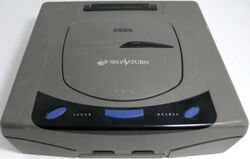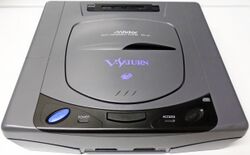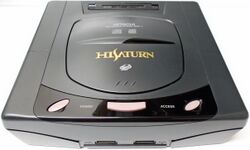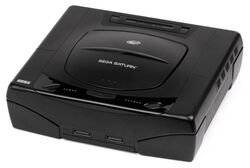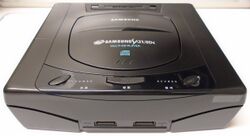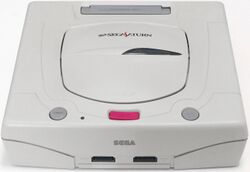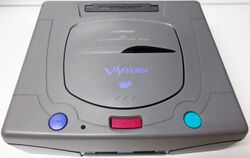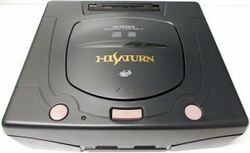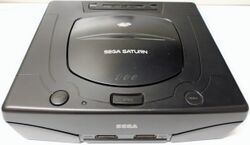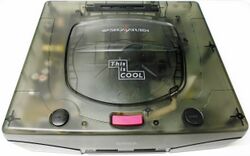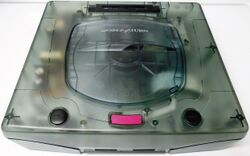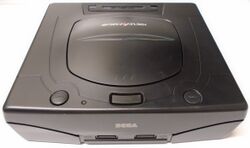Sega Saturn
From Sega Retro
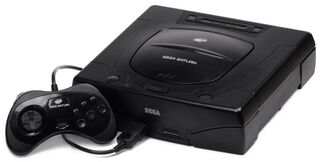
| |||||||||||||||||||||||||||||||||||||||||||||||||||||||||||||||||||||||||||||||||||||
| Sega Saturn | |||||||||||||||||||||||||||||||||||||||||||||||||||||||||||||||||||||||||||||||||||||
|---|---|---|---|---|---|---|---|---|---|---|---|---|---|---|---|---|---|---|---|---|---|---|---|---|---|---|---|---|---|---|---|---|---|---|---|---|---|---|---|---|---|---|---|---|---|---|---|---|---|---|---|---|---|---|---|---|---|---|---|---|---|---|---|---|---|---|---|---|---|---|---|---|---|---|---|---|---|---|---|---|---|---|---|---|---|
| Manufacturer: Sega Enterprises, Ltd. | |||||||||||||||||||||||||||||||||||||||||||||||||||||||||||||||||||||||||||||||||||||
| Variants: Sega Titan Video | |||||||||||||||||||||||||||||||||||||||||||||||||||||||||||||||||||||||||||||||||||||
| Add-ons: Backup Memory, PriFun, Video CD Card, Extended RAM Cartridge, ROM Cartridge | |||||||||||||||||||||||||||||||||||||||||||||||||||||||||||||||||||||||||||||||||||||
|
The Sega Saturn (セガサターン), is a video game console manufactured by Sega as a successor to the Sega Mega Drive. It is a 32-bit compact disc-based system first released in November 1994 in Japan, before a Western launch across the following summer.
Depending on where you live, the Saturn could be described as either Sega's most successful console of all time (Japan) or one of their biggest commercial failures (North America). Despite being powerful for its time, its complex hardware and inability to meet rapidly evolving consumer demands put it in a distant third place in the Western world, but a combination of 2D sprite games, 3D arcade ports and strong marketing campaigns made the Saturn the most successful Sega console in Japan. Estimates for the total number of Saturns sold worldwide range from 9.5 million to 17 million.[17]
The Saturn's main competitors were Sony's PlayStation released just a week after the Saturn in Japan, and the Nintendo 64 from June 1996. Its arcade counterpart was the Sega Titan Video (ST-V) system. It was succeeded by the Sega Dreamcast in late 1998.
"Saturn" was an internal codename that was carried through to the final product. It was named as such because Saturn is the sixth planet in our solar system, and this was Sega's sixth home console. Other Sega systems would also receive planet codenames over the next few years.
Hardware
The Sega Saturn is the successor to the Mega Drive, though as a video game system it is almost entirely different. It is a "32-bit" console, marketed in such a way that it appeared to be an evolution of the "16-bit" era of video gaming dominated by the Mega Drive and Super NES (which in turn succeeded the "8-bit" Master System and NES, respectively).
This description, however, was initially fabricated - Sega of Japan originally claimed the Saturn was a "64-bit" console[18] and some within Sega even chose to call it an "128-bit" machine,[19] a number arrived at by cumulating processors rather than simply picking the main CPU. Alternatively some areas of Sega simply went down the "multi-processor" route, refusing to get drawn into the perceived differences between 32-bit and 64-bit.[20] This was incidentally the last video game generation where these so-called "bit wars" were considered to matter.
The system uses CD-ROMs as its primary choice of media. Though it contains a cartridge slot, this is not used for games, but rather backup memory or RAM cartridges. The former was to extend the space for save games beyond that of the Saturn's internal memory, while the latter was used to augment the Saturn's limited memory and to avoid long CD load times.
The Saturn has two controller ports, and the standard Saturn controller builds on that seen in the six button Sega Mega Drive controller. It adds two shoulder buttons, first seen on the Super NES controller, bringing the amount of buttons up to nine. The 3D Control Pad, released later with NiGHTS into Dreams, would supply the console with an analogue stick and analogue shoulder buttons, the latter later being used in the Sega Dreamcast before being adopted by Nintendo and Microsoft for their GameCube and Xbox consoles, respectively.
The Sega Saturn hardware combined features from several Sega arcade systems.[21] It has a multi-processor system, like arcade machines. Its geometry engine consists of three DSP math processors, two inside both Hitachi SH-2 CPU and one inside the SCU, which were all intended to be programmed in parallel using complex assembly language, similar to how Sega programmed 3D arcade games at the time.
The VDP1 combined features from the Sega System 32 and the Sega Model series, with a quad polygon engine based on the Model 1, and texture mapping capability based on the Model 2 and System 32. The VDP1 is capable of drawing more polygons than the Model 1, but less than the Model 2. The Saturn was also influenced by the Sega Model 1's use of a separate graphics processor for the 2D backgrounds (based on the Sega System 24). The quad polygons are drawn with edge anti‑aliasing (for smoother edges), forward texture mapping (a form of perspective correction), bilinear approximation (reduces texture warping), and medium polygon accuracy (resulting in seamless polygons).[22]
The Saturn's VDP2 was based on Sega System 32 technology (an evolution of Super Scaler technology), used for both 2D backgrounds and 3D planes; the latter can be manipulated as polygon objects. The VDP2's tiled infinite plane engine uses tilemap compression and a form of scanline/tiled rendering to draw large, detailed, 3D texture-mapped infinite planes (for things such as grounds, seas, walls, ceilings, skies, etc.), with perspective correction and a virtually unlimited draw distance (and capable of effects such as transparency, parallax scrolling, reflective water surfaces, fog/misting,[23] fire, and heat haze), at a very high tile fillrate for its time.
The VDP2 draws 3D infinite planes as large as 4096×4096 pixels at 30 FPS, equivalent to a fillrate of over 500 MPixels/s, significantly larger than what any console or PC hardware were capable of with polygons at the time. It requires 1 million texture-mapped polygons/sec, with 500 pixels per polygon, to draw a texture-mapped 4096×4096 infinite plane at 30 FPS; the Dreamcast was the first home system capable of doing this with polygons, as it was the first home system that exceeded 500 MPixels/s polygon fillrate (using tiled rendering).
The Saturn was known for its difficult 3D development environment (especially for third-party developers), including its complex parallel processing hardware architecture, requiring familiarity with assembly language, lack of an operating system, and initial lack of C language support, useful development tools and graphics software libraries. Sega eventually provided DTS support for these features in late 1995. However, the C language development tools were not very well optimized for Saturn hardware, only tapping into a fraction of the Saturn's power, compared to assembly language which could tap into most of the Saturn's power. For example, the libraries did not use the SCU DSP, nor were they well-optimized for a multi-core CPU setup.[24] Some of the advanced techniques used by Sega's first-party AM studios did not become available until the introduction of SGL (Saturn Graphics Library).[25]
Only a handful of developers were able to squeeze most of the power out of the second SH-2 CPU, and even fewer utilized the SCU DSP, as its assembly code was more complex than the SH-2. Assembly language was often used by Japanese and British developers, but rarely used by American developers who preferred C language.[26] The VDP1 rendered quadrilateral polygons, which, despite being used by the most powerful gaming system at the time (Sega Model 2 arcade system), did not become industry standard for 3D graphics, compared to the more widely used triangle polygons.
The VDP2's tiled infinite plane engine, which could draw large 3D infinite planes with a much higher draw distance, texture details and fillrate than polygons at the time, was unfamiliar to most developers who relied on polygons to construct 3D planes. Sega's first-party 3D games often utilized both CPU, the DSP, and/or both VDP, but the hardware's complexity and difficult 3D development environment led to most third-party developers only utilizing a single CPU and the VDP1, just a portion of the Saturn's power, for 3D games. This was also partly due to the advanced techniques used by Sega's first-party studios being unavailable to third-party developers until the introduction of SGL.[25] While the VDP2 was under-utilized for 3D games, it was frequently used for 2D games, where the VDP1 draws sprites and the VDP2 draws scrolling backgrounds.
Models
- Main article: Sega Saturn consoles.
There are a variety of Sega Saturn models of different shapes and colours, as well as novelty units, such as the Game & Car Navi HiSaturn. Differences between systems are not as drastic as seen with the Sega Mega Drive - the same basic feature set and component designs were used throughout the console's lifespan in all regions.
HST-3200/HST-3210
First seen on launch day in Japan (1994-11-22), the HST-3200 (later revised and released as the HST-3210, although the differences aside from a BIOS update are not fully understood), commonly referred to as the "grey Saturn" (although during development it had a metallic finish), was the basis for all Sega Saturns released between the Japanese launch and early 1996. These Saturns use blue "oval" buttons, mounted to black plastic at the front of the unit, and have both "power" and "access" LEDs similar to the Sega Mega-CD.
The Saturn saw variants produced by Hitachi and JVC as the HiSaturn and V-Saturn respectively, though aside from altered BIOSes and aesthetics (and bundles/pricing) these do not deviate much from the Sega designs. Novelty value sees these models worth slightly more in pre-owned markets - fewer were produced than the Sega models, but compatibility rates are much the same.
Overseas versions are physically identical (save for region encoding), but use black plastic throughout.
HST-3220
Announced at Sega Saturn Power Up Meeting '96 Spring and released on 22nd March 1996[27], the HST-3220 stands as the only significant change to the Saturn's design, although functionality wise, the only feature omitted is the "access" LED seen in previous models. Reportedly the change in colour scheme was made to appeal to younger and female demographics.[28]
These "white" Saturns likely cost less to produce (they were certainly sold for a lot less in Japan), but from a user perspective the change is largely negligible - the console is roughly the same size and has no problems running any Saturn software. White Saturns opt for grey "circle" power and reset buttons and a pink "open" button for lifting the lid.
It is rumoured, though not proven, that the HST-3220 has a faster disc reading time than its earlier counterparts, meaning quicker loading screens in games.
When brought overseas the console continued to be shipped only in black, although the North American and European models have different coloured buttons. In 1998 Sega started releasing special versions of these consoles with semi-transparent plastic under the "This is cool" brand - only 30,000 units were produced. Again aside from aesthetic differences the consoles are interchangeable.
Some of the Japanese colour designs were also brought to Brazil.
Hardware revisions
- Main article: Sega Saturn/Hardware revisions.
Technical specifications
- Main article: Sega Saturn/Technical specifications.
Hardware comparisons
- Main article: Sega Saturn/Hardware comparison.
History
- Main article: History of the Sega Saturn.
Localised names
| Language | Localised Name | English Translation |
|---|---|---|
| English | Sega Saturn | Sega Saturn |
| Japanese | セガサターン | Sega Saturn |
| Korean | 삼성새턴 | Samsung Saturn |
| Chinese (Traditional; Hong Kong) | 世嘉土星 | Sega Saturn |
| Hebrew | סאטורן |
Emulation
| Name | Operating System(s) | Latest Version | Active | Source/License |
|---|---|---|---|---|
| SSF | Windows | 0.12 beta R4 | ✓ | Closed |
| Mednafen | Windows 64bits / GNU/Linux 64bits | 1.21.3 | ✓ | Open / GNU GPLv2 |
| Yabause | Windows / Mac / GNU/Linux / FreeBSD / Dreamcast / Android | 0.9.15 | ✓ | Open / GNU GPLv2 |
| Yaba Sanshiro (old uoYabause) | Android / iOS / Windows | 1.8 | ✓ | Part Open / Part not public yet (Fork of Yabause) / GNU GPLv2 |
| Kronos | GNU/Linux / Windows | 2.6.1 | ✓ | Open (Fork of Yaba Sanshiro) / GNU GPLv2 |
| Nova | Windows | 0.2 | ✓ | Closed |
| MAME | Multi-platform | 0.192 | ✓ | Open / GNU GPLv2 |
| Satourne | Windows | 2.0 beta 3 | ✗ | Closed |
| Saturnin | Windows | 0.40 | ✗ | Closed |
| GiriGiri | Windows | 0.6 | ✗ | Closed |
Software that plays files in the Saturn Sound Format, which stores audio ripped from games, does so through emulation of the audio-related code only.
Games
- Main article: Sega Saturn games.
Production credits
Japanese version
- Hideki Sato
- Designer: Kazuhiko Hamada
- Hiroyuki Ohtaka
- Start-up Jingle: Katsuyoshi Nitta
Magazine articles
- Main article: Sega Saturn/Magazine articles.
Promotional material
- Main article: Sega Saturn/Promotional material.
Logos by regions
| Logo | Region |
|---|---|
| Used in Japan, Asia, parts of Eastern Europe and South Korea (from 1997) | |
| Used in North and South America, Western and Eastern Europe, Asia, Africa, Australasia | |
| Used in South Korea | |
| Used in South Korea (magazine advertisements) |
Patents
External links
- Dave's Sega Saturn Page - Famous fansite that was extremely popular during the Saturn's heyday (no longer updated).
References
- ↑ 1.0 1.1 File:Saturn JP TVAdvert SaturnFromSaturn.mp4
- ↑ 2.0 2.1 Computer & Video Games, "July 1995" (UK; 1995-06-09), page 7
- ↑ Computer & Video Games, "August 1995" (UK; 1995-07-12), page 30
- ↑ 4.0 4.1 Ultimate Future Games, "August 1995" (UK; 1995-07-01), page 12
- ↑ Ação Games, "Setembro 1995" (BR; 1995-09-16), page 10
- ↑ Video Game, "Outubro 1995" (BR; 1995-xx-xx), page 36
- ↑ New Straits Times 1997-03-13 Video game war front opens in Asia
- ↑ File:ConsolesMicro FR 01.pdf, page 13
- ↑ Sega Magazin, "August 1995" (DE; 1995-07-12), page 6
- ↑ Hobby Consolas, "Julio 1995" (ES; 1995-xx-xx), page 28
- ↑ Hobby Consolas, "Noviembre 1995" (ES; 1995-xx-xx), page 26
- ↑ 12.0 12.1 Alaab Alcomputtar, "" (SA; 1995-06-xx), page 9
- ↑ Alaab Alcomputtar, "" (SA; 1995-06-xx), page 12
- ↑ File:SecretService_34_PL_Bobmark.png
- ↑ File:Migr 1 RU.pdf, page 57
- ↑ https://www.telecompaper.com/news/32bit-consoles-to-be-launched-in-may-1996--81064
- ↑ History of the Sega Saturn/Decline and legacy
- ↑ File:SegaSaturn64BitJPCatalog.pdf, page 3
- ↑ Edge, "September 1995" (UK; 1995-07-27), page 9
- ↑ Hyper, "February 1994" (AU; 199x-xx-xx), page 8
- ↑ Technology That Defines the Next Generation: The Sega Saturn White Paper
- ↑ Sega Saturn 3D Capabilities
- ↑ Sega Saturn Magazine, "October 1997" (UK; 1997-09-17), page 25
- ↑ Pure Entertainment Interview
- ↑ 25.0 25.1 Jason Gosling (Core Design) Interview (Edge)
- ↑ Edge, "March 1996" (UK; 1996-02-09), page 99
- ↑ Saturn Fan, "1996 No. 7" (JP; 1996-03-15), page 25
- ↑ Maximum, "April 1996" (UK; 1996-04-27), page 127
- ↑ File:Sega_Consumer_History_JP_EnterBrain_Book.pdf, page 23
- ↑ Sega Saturn Magazine, "June 1995" (JP; 1995-05-08), page 65
- ↑ https://www.facebook.com/hiroyuki.ohtaka/about_work_and_education
- ↑ http://blog.livedoor.jp/kat_nitta/archives/3033512.html
| Sega Home Video Game Systems | ||||||||||||||||||||||||||||
| 83 | 84 | 85 | 86 | 87 | 88 | 89 | 90 | 91 | 92 | 93 | 94 | 95 | 96 | 97 | 98 | 99 | 00 | 01 | 02 | 03 | 04 | 05 | 06 | 07 | 08 | 09 | 10 | 11 |
|---|---|---|---|---|---|---|---|---|---|---|---|---|---|---|---|---|---|---|---|---|---|---|---|---|---|---|---|---|
| SG-1000 | SG-1000 II | Mega Drive | Mega Drive II | |||||||||||||||||||||||||
| SC-3000 | Mega-CD | Mega-CD II | Genesis 3 | |||||||||||||||||||||||||
| Sega Mark III | 32X | Dreamcast | ||||||||||||||||||||||||||
| Master System | Master System II | |||||||||||||||||||||||||||
| AI Computer | Game Gear | |||||||||||||||||||||||||||
| Saturn | ||||||||||||||||||||||||||||
| Pico | Beena | |||||||||||||||||||||||||||
- JP Saturn hardware
- US Saturn hardware
- EU Saturn hardware
- DE Saturn hardware
- ES Saturn hardware
- FR Saturn hardware
- NL Saturn hardware
- UK Saturn hardware
- PL Saturn hardware
- AU Saturn hardware
- BR Saturn hardware
- KR Saturn hardware
- RU Saturn hardware
- SA Saturn hardware
- AS Saturn hardware
- Saturn hardware
- Credits without reference
- Sega Saturn
